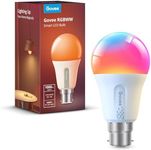Buying Guide for the Best Led Smart Bulbs
Choosing the right LED smart bulb can significantly enhance your home lighting experience. Smart bulbs offer convenience, energy efficiency, and the ability to customize your lighting to suit your mood or activity. When selecting an LED smart bulb, it's important to consider several key specifications to ensure you get the best fit for your needs.Brightness (Lumens)Brightness is measured in lumens and indicates how much light the bulb emits. This is important because it determines how well the bulb will illuminate a space. For general room lighting, look for bulbs with higher lumens, typically around 800-1000 lumens. For accent lighting or mood lighting, lower lumens, such as 450-800, may be sufficient. Consider the size of the room and the purpose of the lighting when choosing the brightness level.
Color Temperature (Kelvin)Color temperature, measured in Kelvin, describes the color of the light emitted by the bulb. This is important for creating the desired ambiance in a room. Lower Kelvin values (2000-3000K) produce warm, yellowish light, ideal for cozy, relaxing environments like living rooms and bedrooms. Higher Kelvin values (4000-6500K) produce cool, bluish light, suitable for task lighting in kitchens, offices, or bathrooms. Choose a color temperature based on the mood you want to set and the activities that will take place in the room.
ConnectivityConnectivity refers to how the smart bulb connects to your home network and other devices. This is important for ease of use and integration with your smart home system. Common connectivity options include Wi-Fi, Bluetooth, and Zigbee. Wi-Fi bulbs offer direct control via your home network, while Bluetooth bulbs connect directly to your phone or tablet. Zigbee bulbs require a hub but can integrate seamlessly with other Zigbee devices. Choose a connectivity option that matches your existing smart home setup and offers the level of control you desire.
CompatibilityCompatibility refers to whether the smart bulb works with your existing smart home ecosystem, such as Amazon Alexa, Google Assistant, or Apple HomeKit. This is important for ensuring you can control the bulb using your preferred voice assistant or smart home app. Check the bulb's compatibility with your devices and platforms to ensure seamless integration and control. If you use multiple smart home systems, look for bulbs that support multiple platforms.
Dimming and Color Changing FeaturesDimming and color changing features allow you to adjust the brightness and color of the light to suit different activities and moods. This is important for creating a versatile lighting environment. Some bulbs offer simple dimming, while others provide a full spectrum of colors and shades. If you want to create dynamic lighting scenes or match the lighting to specific activities, look for bulbs with advanced dimming and color changing capabilities. Consider how often you will use these features and whether they are essential for your lighting needs.
Energy EfficiencyEnergy efficiency indicates how much energy the bulb consumes compared to the amount of light it produces. This is important for reducing electricity costs and environmental impact. Look for bulbs with high energy efficiency ratings, such as those labeled with ENERGY STAR certification. These bulbs use less power while providing the same level of brightness as less efficient bulbs. Consider the long-term savings and environmental benefits when choosing an energy-efficient bulb.
LifespanLifespan refers to how long the bulb is expected to last before it needs to be replaced. This is important for convenience and cost-effectiveness. LED bulbs typically have a longer lifespan than traditional incandescent bulbs, often lasting 15,000 to 25,000 hours or more. Choose bulbs with longer lifespans to reduce the frequency of replacements and maintenance. Consider how often you use the bulb and the ease of replacing it when evaluating lifespan.
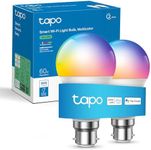
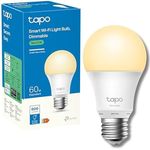
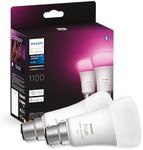



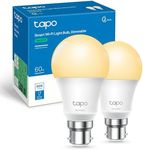

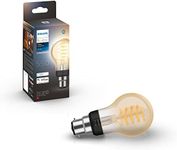
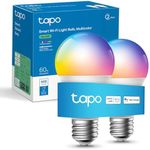
![Philips Hue White A60 Smart LED Light Bulb [E27 Edison Screw] for Home Indoor Lighting with Amazon Echo and Alexa](https://images-proxy.bestreviews.guide/63R0COrMTv5QaLm8bxW71dVnXHg=/0x150/https://m.media-amazon.com/images/I/418MRVX9PjL._AC_CX679_.jpg)
![Philips Hue White & Colour Ambiance Single Smart Bulb LED [B22 Bayonet Cap] - 1600 Lumens (100W Equivalent). Works with Alexa, Google Assistant and Apple Homekit](https://images-proxy.bestreviews.guide/g8Xpx5uue92--_jYRHu5gf7AX8A=/0x150/https://m.media-amazon.com/images/I/41C3JOXL9ML._AC_CX679_.jpg)
![Avatar Controls Smart Bulb Alexa Light Bulbs B22 Bayonet, Colour Changing WiFi LED Lamp Bulbs 9W Set of 2 Bulbs [Energy Class F], White](https://images-proxy.bestreviews.guide/IlkwBm0L5I2jc78i3-kbMvwNlDM=/0x150/https://m.media-amazon.com/images/I/41TtfxqXajL._AC_CX679_.jpg)

